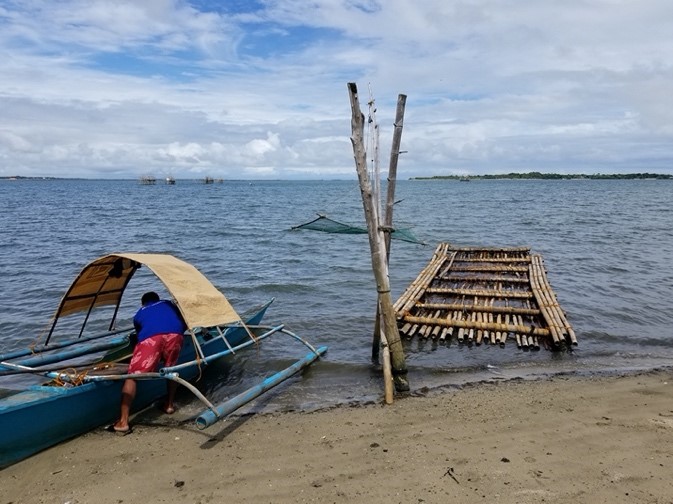Enhancement Blog– Philippine Research Trip

In our last post, we planned out our goals for the first trip to the Philippines; we were to visit the various hatcheries on different islands, decide on a location where we can conduct our mark-release & recapture study, and initiate conversations and potential collaborations with various institutions. Once we reached the island of Cebu, we met our host, Marinelle Espino – the program manager of PACPI (the Philippines Association of Crab Producers INC.) and had an introductory meeting with the board members of PACPI.

Our meeting with PACPI – from left to right: Marinelle Espino, Ronnie Florentino, Oded Zmora, Gabriel Ng, Ken Choi
PACPI has been culturing and releasing blue swimmer crab juveniles for several years now in collaboration with two hatcheries on the islands of Bohol and Negros. We next set out to travel to these hatcheries as potential sites to conduct our research. Traveling to the hatcheries was an experience in itself. The travel involved taking ferries, short plane trips, and shuttles, but this also allowed us to experience the varied landscapes within the Philippines. When we arrived in the hatcheries, the folks there greeted us with nothing but hospitality. We toured the hatchery facilities and saw how the blue swimmer crabs were raised from zoeae to juveniles.

Touring the Bohol hatchery and observing blue swimmer crab zoeae
While visiting these hatcheries, we also scouted potential field sites where we can release our tagged crabs. Both the Negros and Bohol hatcheries have been releasing juveniles in nursery habitats within protected areas. These sites are ideal habitat for juvenile crabs but are logistically hard to access. Since they are protected areas, we do not want to disturb these environments from our resampling protocols.

Touring and meeting the hatchery specialists in Negros
Instead, we scouted out the area right by the Bohol hatchery. This stretch of muddy intertidal and subtidal area consists of mudflats, seagrass beds, and coral reefs. Past the coral reefs lies a deeper channel where adult blue crabs are present. The technicians working at the hatchery have observed wild juvenile blue swimmer crabs in the mudflat and seagrass habitat, suggesting that this area might be an ideal site for us to conduct the mark-recapture study since the crabs can utilize these different habitats as they mature.

Touring the hatchery facility at SEAFDEC (Southeast Asian Fisheries Development Center) with Joana Joy Huervana
In addition to visiting the various hatcheries and field sites, we also met with the government agency, the Bureau of Fisheries and Aquatic Resources, and the research institutions of Southeast Asian Fisheries Development Center and University of Philippines Visayas. This project requires collection permits and permission to work in certain areas, and by introducing our projects to government agencies and emphasizing the importance of this research for the crab fishery, we hope to facilitate the permitting process. We also wanted to initiate conversations with different research institutions; this is a potentially large-scale project and we do not know much of the local knowledge/biology of the crabs here. By meeting with professors and researchers who have worked in this system, we hope to build capacity with them, initiate a flow of information and ideas, and create potential collaborations.

Meeting with Professor Emilia Santos-Yap at the University of Philippines Visayas
It was during this portion of our trip that we started getting notifications about COVID-19 expanding in the US. Furthermore, several islands in Philippines began to quarantine and restrict travel to the islands temporarily. Thus, we had to cut our trip a week short but safely made it back to the US. Despite shortening our trip we accomplished most of our objectives and learned a great deal during this trip and are looking forward to our eventual return to the Philippines.
